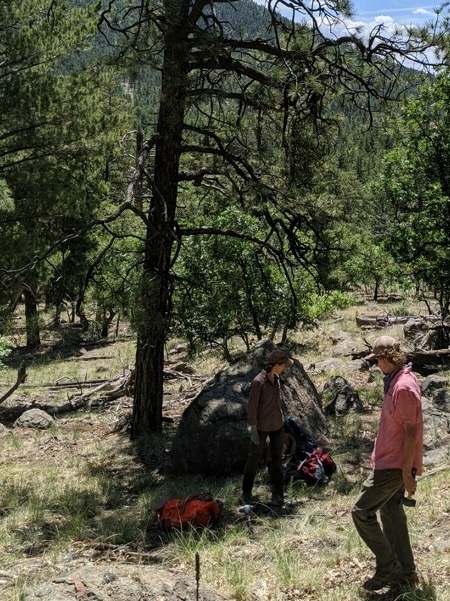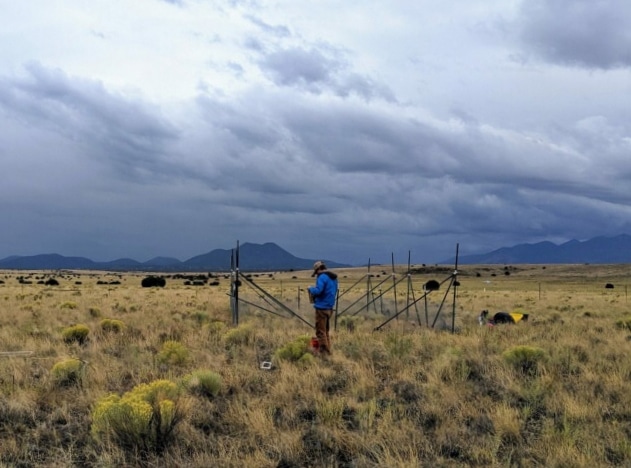Ethan Taber was a horticulturist in Montana when the Lolo Peak Fire tore through the forests outside of Missoula. He listened as his peers argued about fires, forest health and what needed to happen to help the forests recover. No one agreed on the best fire management strategies.
Taber, whose background was in botany and sustainability, didn’t know either, but he was curious. When he decided to go to graduate school, fire recovery was on a short list of research topics he wanted to study. And that put NAU on a short list of potential grad schools.
Now he’s completed one graduate degree in environmental science and policy as a Lumberjack and, with the help of the prestigious Graduate Research Fellowship (GRFP) from the National Science Foundation, he’s starting his Ph.D. at NAU in the fall, allowing Taber the opportunity to continue his research on the regeneration of the Museum Fire site and the increased risks of fire and forest loss that are exacerbated by climate change.
“Our work seeks to provide guidance for future forest restoration efforts,” he said. “We need to know the potential for forests to change in order to work toward avoiding detrimental changes or recovering from them.”
Rachel Mitchell, an assistant professor in the School of Earth and Sustainability and Taber’s adviser, said the continuation of this research will be critically important in managing forest ecosystems. Taber’s commitment and drive was evident in his master’s program, which he completed in two years with field work, during a pandemic and a couple of extra challenges that are inherent to the work they do.
“I am always impressed with his hard work and dedication,” she said. “Because our field site is located in a burned area, there is high risk from falling trees, which can sometimes limit when Ethan can be out collecting data. Even a moderately breezy day can really elevate the risks from falling trees. During a recent field excursion, Ethan told me that at one point, in order to avoid dangerous wind, he was at times collecting plant samples in the middle of the night. That is some serious dedication!”
Museum Fire research
During his master’s degree, Taber studied plant regeneration on the 2019 Museum Fire and the risk of fires and floods on the scar, which is on the mountainsides just north of Flagstaff. He and Mitchell looked at the effects of fire severity and climate warming on understory plant communities. In their research, they found that climate warming has the potential to exacerbate changes caused by uncharacteristically high severity fires, while the ponderosa pine forests in northern Arizona are adapted for low severity fires.

“Due to a number of causes, mainly fire suppression efforts, fuel loads have increased and high severity fires are more common than ever,” he said. “Because these forests aren’t adapted to such fires, there is potential for them to change to non-forest ecosystems following high severity fires. Our study is interested in the combined effects of increased burn severity and a warmer climate on forest understory recovery.”
This finding indicates potential for different forest recovery dynamic under near-term (by 2050) climate warming. Though his work is future-oriented and not as useful for immediate recovery of the site, it does highlight some important potential issues. The City of Flagstaff commissioned an analysis of the Museum Fire site, which showed the flood risk has not decreased because Flagstaff has not gotten a good monsoon season in the last two years, which means plants haven’t returned to their pre-fire growth.
“In short, forests may be on altered successional trajectories following future high severity fires,” he said. “That said, we still don’t know what this succession will look like, but there is potential for a shift toward non-forest ecosystems.”
“Forests provide ecosystem services, including erosion control, groundwater recharge, carbon sequestration and lots of scenic and recreational value,” he said. “It is important to know the risk that forest ecosystems face in order to effectively manage them.”
Much of this type of research focuses on tree regeneration—that makes sense, it’s a forest. But forest growth includes so many more species than just trees; the work Taber is doing looks at the understory plant community, which make up the majority of the biodiversity in ponderosa pine forests. These communities provide pollinator resources and food for wildlife and are significant contributors to hydrological and geologic dynamics in an area. The understory also affects tree regeneration.
Next research steps
Since Taber is staying at NAU, he can transition his master’s research into a more in-depth project. He wants to study how warming affects recovery over a longer time scale and look at understory species’ interactions and how the presence or absence of certain species might affect the presence or absence of other species.
He also plans to return to the Museum Fire site to study the ponderosa pine seedling establishment. In his application to the NSF, Taber discussed the need to move beyond a snapshot of immediate post-fire impacts and incorporate the temporal trajectories of community and functional change in response to environmental conditions over several years. Especially in light of the recent epidemic of fires in the western United States, getting this information to fire and forest managers is of vital importance.
Taber, who taught classes during his master’s program and will continue to do so as a Ph.D. student, also plans to develop a lab curriculum for an undergraduate ecology class and an interactive activity for the Flagstaff Festival of Sciences, and he anticipates sharing his research at other academic symposia focused on fire science and ecology.
The GRFP also gives him more flexibility in his research, and the same curiosity that led him to fire science is leading him to asking more questions as the conversations around climate change, forest management and sustainability continue.
“I’m still coming up with new ideas,” Taber said.
Applying for the GRFP
The GRFP was on Taber’s radar for a while; he knew he wanted to get a Ph.D. and knew that funding was a good way to pay for it. He waited until the second year of his master’s program to apply so he could have a stronger application with more research experience. He started on the application in August—an entire academic year before he found out he won.
“In total, I had eight revised versions after my initial draft,” he said. “I submitted the ninth draft.”
Though not an astronomy student, he enrolled in AST 599, a course that astronomy professor Ty Robinson teaches that covers how to write for grants and awards like this one. Many winners come out of this class every year; it offers the opportunity not only for writing and editing but to get feedback from professors and other students while also creating deadlines and processes that mirror the application process of these major awards.
Mitchell, who has worked with Taber since he came to NAU in 2019, including dozens of hours monumenting and collecting data on the Climate, Fire and Function (CliFF) experiment, also worked with him on his application, helping him get to that winning final draft. She has been impressed with his work in the classroom, in the field and writing for the entirety of his program.
“I am really proud of Ethan for winning the GRFP; he worked very hard on that application and his leadership characteristics and potential as a scientist really came through,” she said. “I am excited to see how he leverages the next four years here at NAU to ask interesting and exciting questions about climate change impacts in western forests.”
Six NAU students were selected for the National Science Foundation’s Graduate Research Fellowship Program. Read about their research.
Megan Gialluca: Dark matter amid the dark skies: In four years at NAU, research takes grad to the ends of the universe
Jessica Archibald: Managing mangroves: GRFP recipient Jessica Archibald studies social-ecological approaches to forest restoration
Jonathan Chin: Building a better solar panel: NAU graduate wins NSF award to continue research into sustainable energy
Heidi Toth | NAU Communications
(928) 523-8737 | heidi.toth@nau.edu




